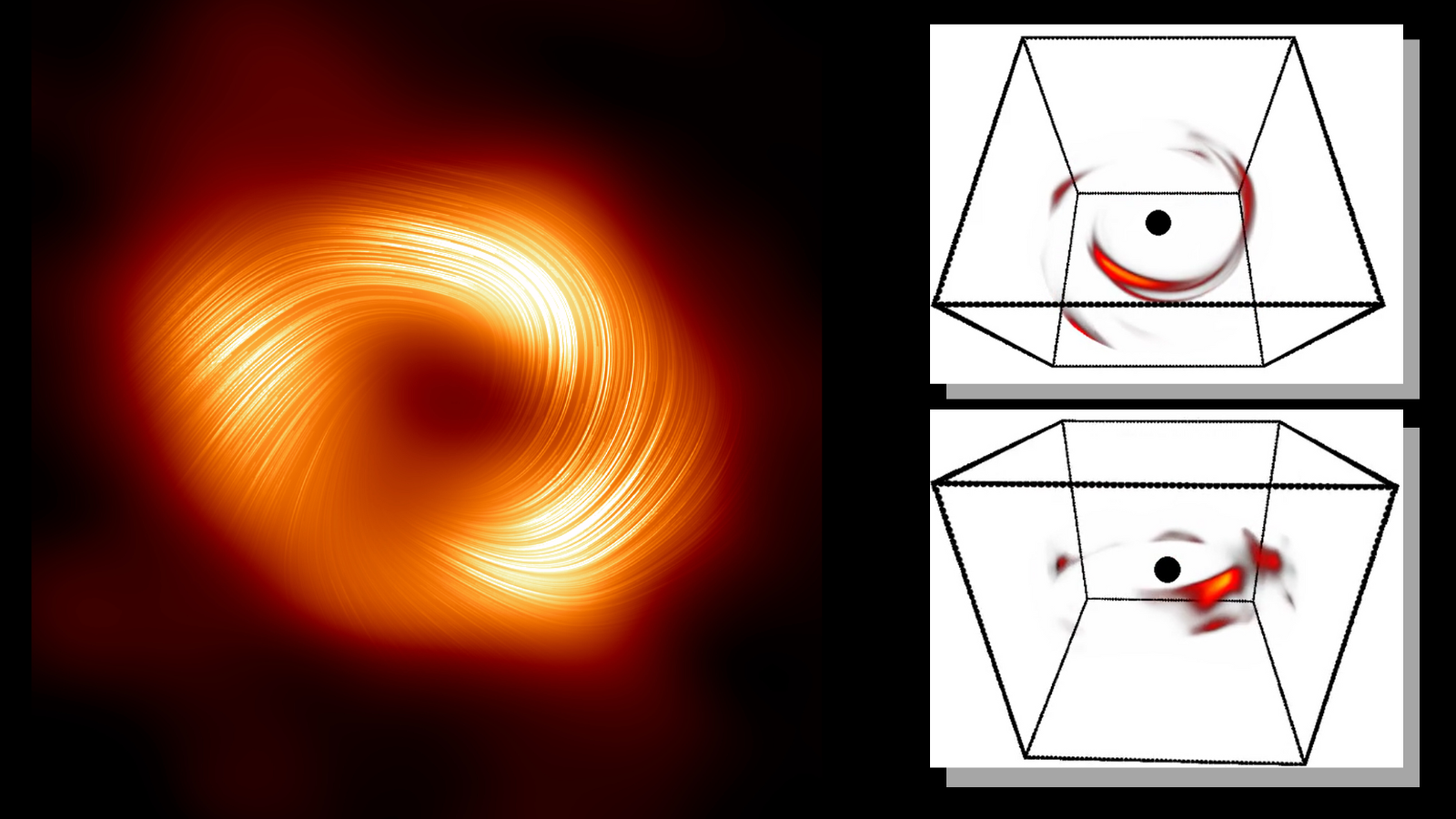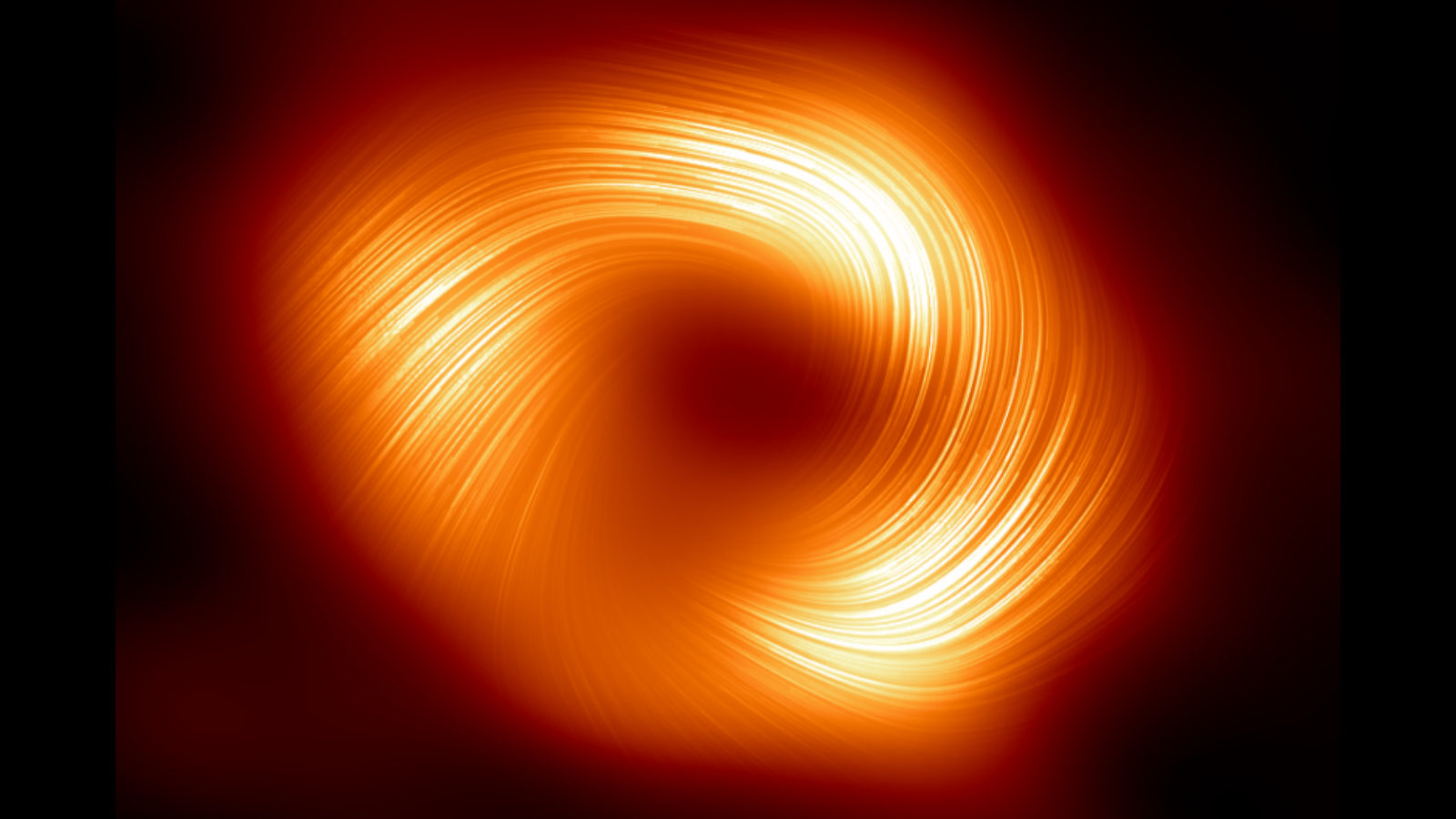Scientists use AI to reconstruct energetic flare blasted from Milky Way's supermassive black hole
"This work is a unique collaboration between astronomers and computer scientists advancing cutting-edge computational tools from both the fields of AI and gravitational physics."

Scientists have used artificial intelligence to construct a three-dimensional model of an energetic outburst, or flare, that occurred around the Milky Way's central black hole, Sagittarius A* (Sgr A*). This 3D model could help scientists develop a clearer picture of the tumultuous environment that forms around supermassive black holes in general.
The material swirling around Sgr A* exists in a flattened structure called an "accretion disk" that can periodically flare. These flares occur across a range of light wavelengths, all the way from high-energy X-rays to low-energy infrared light and radio waves.
The supercomputer simulations suggest a flare seen by the Atacama Large Millimeter/Submillimeter Array (ALMA) on April 11, 2017 originated from two bright spots of dense material in Sgr A*'s accretion disk, both of which were facing Earth. Those bright spots swirl around the supermassive black hole, which has a mass around 4.2 million times that of the sun, while separated by around half the distance between the Earth and the sun. That's around 47 million miles (75 million kilometers).
Reconstructing these flares in 3D from observational data is no mean feat. To tackle this, the team, led by California Institute of Technology scientist Aviad Levis, proposed a new imaging technique called "orbital polarimetric tomography." The method is not unlike medical computed tomography, or CT, scans carried out in hospitals around the globe.
"The compact region around the galactic center is an extreme place where hot, magnetized gas orbits a supermassive black hole at relativistic velocities [speeds approaching that of light]. This unique environment powers highly energetic eruptions known as flares, which leave observational signatures at X-ray, infrared and radio wavelengths," Levis told Space.com. "Recently, theorists proposed several mechanisms for the emergence of such flares, one of which is through extremely bright, compact regions that suddenly form within the accretion disk."
The key result of this work, he added, is the recovery of what the 3D structure of radio brightness around Sgr A* might look like directly after a flare detection.
Building a black hole from a single pixel
"Sgr A* lies in the heart of our own Milky Way galaxy, making it the nearest supermassive black hole and a prime candidate to study such flares," Levis said. "To do that effectively, you still need an element of luck when ALMA observations coincide with a flare."
He explained that, on April 11, 2017, ALMA was observing Sgr A* directly after a violent eruption captured in X-rays. The radio data acquired by ALMA had a periodic signal that was consistent with what would be expected for an orbit around Sgr A*.
Breaking space news, the latest updates on rocket launches, skywatching events and more!
"This prompted our development of a computational approach that could extract the 3D structure from the time series data that ALMA observes," Levis added. "In contrast to the Event Horizon Telescope (EHT) 2D image of Sgr A*, we were interested in recovering the 3D volume, and to do that, we relied on physical modeling of how light travels along curved trajectories within the strong gravitational field of a black hole."
To achieve their results, the scientists looked at physics derived from Albert Einstein's 1915 theory of gravity, general relativity, then applied those concepts around supermassive black holes to a neural network. This network was then used create the Sgr A* model.
"This work is a unique collaboration between astronomers and computer scientists advancing cutting-edge computational tools from both the fields of AI and gravitational physics, each contributing an important part of the whole in this first attempt at revealing the 3D radio emission structure around Sgr A*," Levis said. "The result is not a photograph in the regular sense; rather, it is a computational 3D image extracted from time-series observations by constraining a neural network with the expected physics of how gas orbits the black hole and how synchrotron radiation is emitted in the process."
He explained that the team computationally placed 3D "emissions" in orbit around Sgr A*, starting with an arbitrary structure. Through ray tracing, which refers to graphical simulations of the physical behavior of light, Levis and colleagues were able to model how ALMA would see the structure around Sgr A* in future times. Those models started 10 minutes after the flare, then 20 minutes later, 30 minutes later — and so on.
"The technology of neural radiance fields and general relativistic ray tracing gives us a way to start changing the 3D structure until the model matches the observations," Levis added.
The team found that this delivered conclusions about the environment around Sgr A* that are indeed predicted by theory, showing brightness is concentrated at several small regions within the accretion disk. Still, aspects of this work were surprising to Levis and the rest of the team.
"The biggest surprise was that we were able to recover the 3D structure from light curve observations ... essentially a video of a single flickering pixel," the researcher said. "Think about it: if I were to tell you that you could recover a video from just one single pixel, you would say that sounds practically impossible. The key is that we are not recovering an arbitrary video.
"We are recovering the 3D structure of emission around a black hole, and we can leverage the expected gravitational and emission physics to constrain our reconstruction."
Levis added that the fact ALMA measures not just the intensity of light but also its polarization gave the team a highly informative signal with clues about the 3D structure of flares around Sgr A*
Going forward, Levis said he and the team intend to run the simulation while changing the parameters of the physics used to constrain the AI.
"These results are an exciting first step, which relies on the belief that Sgr A* is a black hole whose environment obeys the prescribed gravitational and emission models; the accuracy of our result hinges on the validity of these assumptions," Levis concluded. "In the future, we would like to loosen these constraints to allow deviations from expected physics.
"Our approach, which harnesses the synergy between physics and AI, opens up the door to new and exciting questions whose answers will continue to advance our understanding of black holes and the universe."
The team's research was published on Monday (April 22) in the journal Nature Astronomy.

Robert Lea is a science journalist in the U.K. whose articles have been published in Physics World, New Scientist, Astronomy Magazine, All About Space, Newsweek and ZME Science. He also writes about science communication for Elsevier and the European Journal of Physics. Rob holds a bachelor of science degree in physics and astronomy from the U.K.’s Open University. Follow him on Twitter @sciencef1rst.

